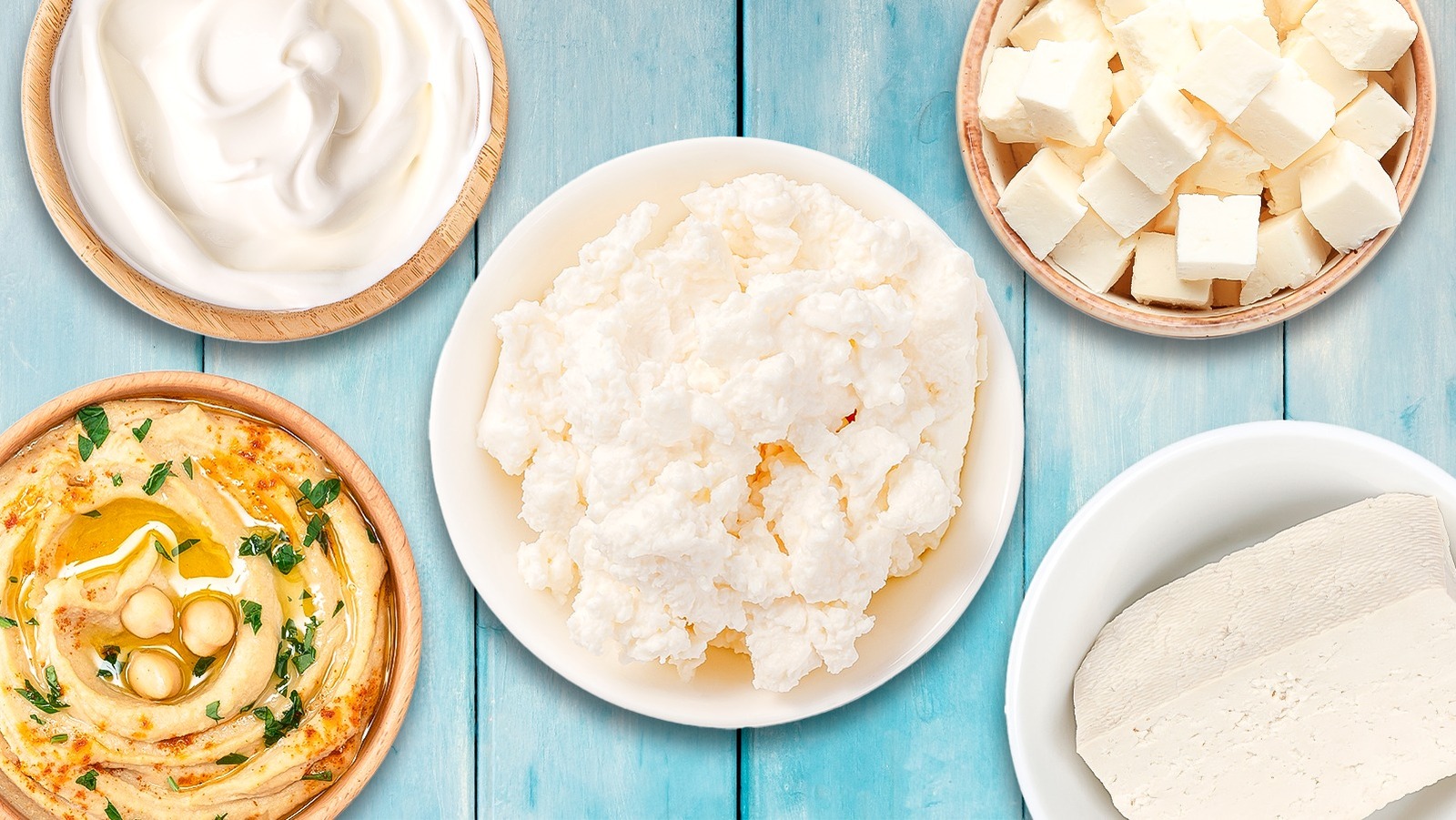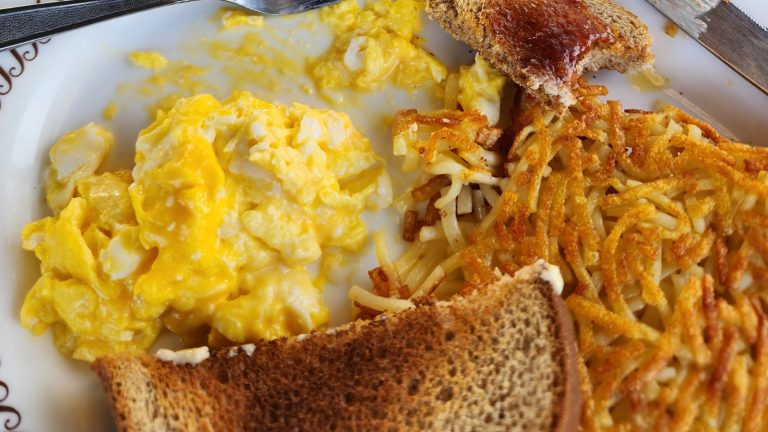Cottage cheese is having its moment. There are tons of great cottage cheese brands out there to choose from and so many creative ways to use the dairy product. You can eat it on its own or utilize it in fun, unexpectedly delicious recipes. But, unfortunately, cottage cheese isn’t exactly a shelf-stable product, so it’s not like you can stock up on a ton of it and always have it on hand. That may mean that there are times when you want to add it to a recipe when you don’t happen to have any in the fridge. And while you can always plan a last-minute grocery run, that’s often not super convenient or cost-effective.
That’s why we’ve compiled this list of cottage cheese substitutes that will ensure you can always get your creamy, cheesy fix. Some of these substitutes offer that cheesy flavor, while others deliver on the texture front. Others will work primarily in savory applications, while a few options can be used for sweet purposes, too. Although there’s no one ingredient that can fully replace cottage cheese in every recipe, you should be able to find at least one ingredient in this list that can function as an adequate replacement in whatever cottage cheese-centric recipe you plan to make.
Ricotta cheese
In terms of texture, there are few ingredients that can replace cottage cheese as well as ricotta cheese. And since it’s a relatively common fridge staple for many dairy lovers out there, you might just have it on hand, waiting for you to use it in a recipe. Of course, there are differences between the two ingredients. Although ricotta is somewhat lumpy, with a less smooth, creamy texture than a lot of cheeses out there (and many of the ingredients on this list), it’s still quite a bit smoother than cottage cheese, which is known for its curds that give it that signature texture. However, both ingredients deliver the creaminess you’d want in a good-quality cottage cheese, which makes it a great replacement for all kinds of pasta and other cheese-based recipes.
There are also a few minor differences flavor-wise: While cottage cheese can be quite tangy and almost salty, ricotta tends toward the sweeter end of the spectrum. That being said, ricotta can be used as a replacement for cottage cheese in both savory and sweet recipes. They both have that fresh, clean, dairy flavor to them, though, which makes ricotta one of our all-time favorite substitutes for cottage cheese.
Kefir
There are so many different recipes that call for dairy products primarily for their creamy texture, and when you’re working with that kind of recipe, you may be able to use kefir as a substitute for cottage cheese. Kefir is a drinkable probiotic, somewhat similar to yogurt, with a distinct tang that it shares with cottage cheese. However, the texture is quite different — kefir is thin enough to drink, while cottage cheese is much more solid and substantial. Still, though, it can be used as a replacement for cottage cheese in some recipes, especially considering that kefir has a saltiness to it that somewhat mimics the flavor of cottage cheese.
You’re best off using kefir in place of cottage cheese when you’re working with a recipe that already requires a lot of moisture. Dips and spreads, for instance, will often require that cottage cheese is somewhat thinned out with water or other liquid ingredients. Since kefir is already a liquid, you might not have to add extra moisture to the recipe. Although kefir may not deliver that chunkiness that cottage cheese is known for, it’ll still offer a rich creaminess to your dish — and plenty of nutrients to boot.
Sour cream
Look up healthy recipe swaps, and you’ll often find that cottage cheese is recommended in place of sour cream. This is because sour cream packs more calories and less protein per serving than cottage cheese, making cottage cheese arguably a healthier alternative. That being said, if you’re less concerned with the health factor than you are with flavor, then you can do that swap the other way around as well, trading cottage cheese in a recipe for sour cream instead.
With sour cream, you’re still going to get that thick, creamy texture, albeit without the curds you may have come to expect from cottage cheese. Plus, sour cream also offers a distinctive tang — perhaps even more so than cottage cheese. It also has a mild, clean, dairy fresh flavor to it that won’t add a ton of bold flavor to an already balanced dish. And since it’s a bit richer and fattier, it can make a cottage cheese-based recipe taste even more decadent than the original. It’s a great ingredient to use when you just want to up the creaminess factor and tang of any recipe you choose to make.
Greek yogurt
If you like cottage cheese, there’s a good chance that you’re a fan of Greek yogurt as well. The two ingredients have a lot in common, which is why it might make sense for you to substitute Greek yogurt for cottage cheese in various recipes. Using cottage cheese because it’s relatively high in protein? Greek yogurt will pack your dish with a similar protein content (although cottage cheese generally contains slightly more protein than yogurt), making it a healthy swap.
But Greek yogurt isn’t just there to replace cottage cheese because of its nutritional makeup. It also has a similarly creamy texture to cottage cheese, although it’s missing those curds that give cottage cheese more texture. Greek yogurt also offers more tanginess to your dish, which is ideal if you’re using an ingredient to brighten the flavor profile of whatever you’re making. Although it may not have that slight saltiness that you may expect from cottage cheese, it’s easy to add a sprinkling of salt to the dish alongside that Greek yogurt to make the flavor a bit more accurate.
Tofu
You may not immediately think of tofu as a good substitute for cottage cheese, largely because it’s not actually a dairy product. But it does share some things in common with the curd-based cheese. First of all, tofu is also relatively high in protein, which will help you feel full and satisfied after you finish your meal. Also, like cottage cheese, tofu has a relatively mild flavor profile. That means it absorbs other flavors well, so you can season it to your liking to create the recipe you have in mind.
Texture-wise, tofu breaks down into a similarly chunky consistency, which gives you an interesting texture that’s not totally dissimilar to cottage cheese. Firm and extra-firm tofu are admittedly missing that creamy component that you may expect from cottage cheese, but you can use silken tofu if you’re trying to capture that creamy consistency specifically. Experiment with different types of tofu as cottage cheese replacements in recipes, and you may find that it offers just what you’re looking for in an ingredient. And the best part? It’s dairy-free and vegan, which is a plus if you choose not to eat dairy for whatever reason.
Hummus
Do you have a container of hummus stashed in the back of your fridge, just waiting to be used up? You’re not alone. After all, once you finish up the pita chips you were using to dip into that hummus, you may not know what to do with the rest of it. But you might just find that it can replace cottage cheese in a variety of recipes. If you’re trying to achieve a rich, creamy consistency and add some protein and fat to the dish in question, it’ll get the job done. You can use store-bought hummus if you want to keep things as simple as possible, but you can also make your own hummus from scratch if you don’t have any of the store-bought variety on hand (or if you just like to keep things fresh).
Just keep in mind that you’re going to want to pay close attention to the flavor of hummus you’re using. Plain varieties will generally work best as a substitute for cottage cheese, considering cottage cheese doesn’t have a super strong flavor on its own. If you do use hummus that contains other ingredients or seasonings, just realize that those flavors will likely make their way into the final dish. That may not always be a bad thing, of course, depending on what you’re making, but it requires a bit more planning than plain cottage cheese does.
Goat cheese
Cottage cheese is, at its core, just cheese, so it makes sense that you’d be able to swap it out with other types of cheese for a similar effect. Goat cheese, for example, can be used as a solid substitute for cottage cheese in many recipes. Goat cheese tends to have a crumbly texture that can somewhat mimic the curds in cottage cheese, although it tends to have less moisture to it, which can leave dishes drier than normal if you don’t add moisture through some other means.
Add goat cheese to pizzas or fancy toast, or use it as a topping to add a touch of creaminess to whatever you’re eating. Just keep in mind that goat cheese tends to be significantly creamier than cottage cheese, so you may want to adjust the amount you’re using if you don’t want to feature quite so much acidity in the dish in question.
Feta
Feta cheese, like goat cheese, has a crumbly consistency that makes it a solid swap for cottage cheese, albeit without the creaminess that you might expect from the original. Sure, that crumbly texture may not perfectly match the curds you’ll find in cottage cheese, but it’s a close enough textural match that it can be used as an adequate replacement in a lot of recipes. Flavor-wise, the two cheeses also share some similarities. Cottage cheese is known for its salty flavor profile, which feta doubles down on — keep in mind that it’s quite a bit saltier than cottage cheese, so adjust accordingly, but we love how it provides the same sort of savory flavor profile to a dish.
Because of that saltiness, feta tends to work best in dishes that use cottage cheese in a more savory way. That being said, if you like a nice salty and sweet flavor combo, you can also pair it with fruit or other sweeter ingredients, just like you might with actual cottage cheese.
Egg whites
You may not think of eggs as an adequate substitute for cheese, but egg whites can absolutely replace cottage cheese in a variety of recipes if you know how to use them correctly. If you’re trying to capture that chunky, curd-like texture of cottage cheese, then you can scramble the egg whites before adding them to whatever recipe you’re making. Since they’re quite neutral in flavor, they should function pretty similarly to cottage cheese when it comes to flavor. Add some salt to the scrambled eggs if you want a closer flavor match.
However, scrambled egg whites aren’t going to give you the creamy texture you may be seeking from a cottage cheese replacement. If that’s the kind of texture you’re going for, you may want to use whipped egg whites instead. Ideally, you’ll want to use a stand mixer to beat your egg whites into the fluffy consistency for which you’re aiming.
Cream cheese
We absolutely love smearing cottage cheese onto toast, bagels, and other carb-y vessels, where its creaminess takes center stage. It’s possible then to layer on other ingredients, like lox, jam, or even chili crisp, or just keep things simple with a sprinkling of salt and pepper. But if you don’t have any cottage cheese on hand, cream cheese can play a very similar function in this sort of snack or light meal, largely thanks to its creamy consistency.
There are a few differences between cottage cheese and cream cheese. Cream cheese is absent the curds that give cottage cheese its unique texture, but it makes up for that lack of curds with a denser, richer texture and mouthfeel. If you do want a lighter texture that’s more similar to cottage cheese, you’re better off using whipped cream cheese instead of regular. As far as the flavor goes, though, these ingredients are quite similar. They’re clean and fresh-tasting, with that rather neutral dairy flavor that works so well with such a wide range of other ingredients.
White bean puree
Whether you’re trying to make a recipe vegan, want to work more fiber into your diet, or are just trying to use up what you already have in your pantry instead of making another trip to the grocery store, you may want to use a white bean puree to replace cottage cheese in some recipes. Like cottage cheese, white bean puree can be used as a filling for a variety of filled pasta, like ravioli. Although you might not think of white beans as a super creamy ingredient, they really can be if you puree them well with some additional liquid. However, if you want to maintain that curd-like consistency, you can also choose to leave some lumps in the puree.
Technically, you can use other types of beans to make a puree that can replace cottage cheese, but we like using white beans specifically because they tend to yield a softer, smoother texture and match the color of actual cottage cheese more closely than other types of beans. And the best part? This is an especially cost-effective substitution.
Whipped heavy cream
For those who love the rich creaminess of cottage cheese in desserts, whipped heavy cream can make for a solid substitute. It’s best used for sweeter applications, since heavy cream doesn’t have the same savory flavor profile that you might expect from cottage cheese. On the texture front, it’s quite a bit lighter than the ingredient it’s replacing, with an airy, silky consistency that makes for a good topping or filling for a variety of desserts.
What heavy cream lacks in terms of its similarities to cottage cheese, though, it makes up for in its rich deliciousness. It’s quite full-bodied in flavor, offering a mouth-filling richness that is actually quite similar to cottage cheese. And sure, it may be a bit more indulgent than its cheesy counterpart, but there’s nothing wrong with an extra touch of indulgence, especially when you’re using it in sweeter recipes.
Mascarpone
Head to the cheese section of your local grocery store to get your hands on some good-quality mascarpone, which can be used in place of cottage cheese in some recipes. There are few cheeses more rich, creamy, and undeniably delicious than mascarpone, which means it will work as a supremely creamy replacement for cottage cheese in various recipes. Since mascarpone tends to be fattier and richer than cottage cheese, it works best as a replacement in recipes that call for full-fat cottage cheese (instead of low-fat or fat-free varieties).
You should consider the difference in texture between these two products before using mascarpone in place of cottage cheese. Because of its smooth consistency, you’ll want to use it in recipes that don’t require those lumpy curds found in cottage cheese. But since it has such a neutral flavor, it can be incorporated into a variety of both sweet and savory recipes. Just make sure to add a pinch of salt if you’re using it in more of a savory context, as mascarpone doesn’t have quite the same salty flavor as does cottage cheese.





